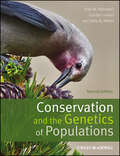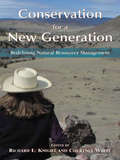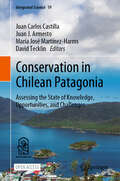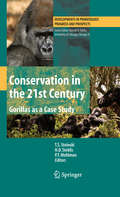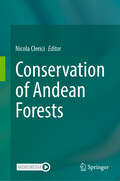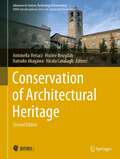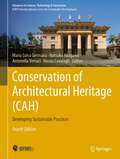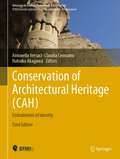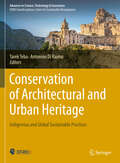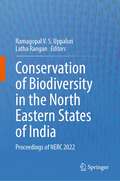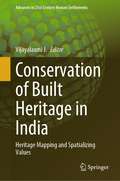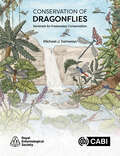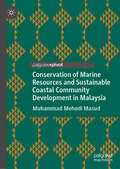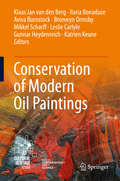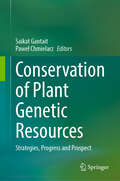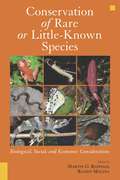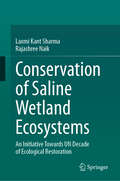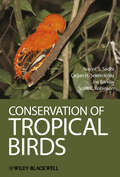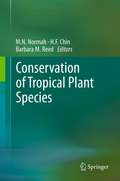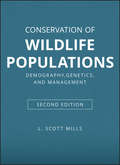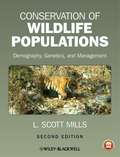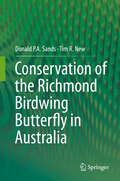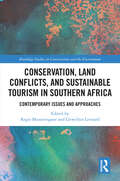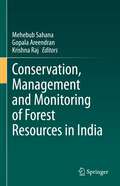- Table View
- List View
Conservation and the Genetics of Populations
by Fred W. Allendorf Gordon H. Luikart Sally N. AitkenLoss of biodiversity is among the greatest problems facing the world today. Conservation and the Genetics of Populations gives a comprehensive overview of the essential background, concepts, and tools needed to understand how genetic information can be used to conserve species threatened with extinction, and to manage species of ecological or commercial importance. New molecular techniques, statistical methods, and computer programs, genetic principles, and methods are becoming increasingly useful in the conservation of biological diversity. Using a balance of data and theory, coupled with basic and applied research examples, this book examines genetic and phenotypic variation in natural populations, the principles and mechanisms of evolutionary change, the interpretation of genetic data from natural populations, and how these can be applied to conservation. The book includes examples from plants, animals, and microbes in wild and captive populations. This second edition contains new chapters on Climate Change and Exploited Populations as well as new sections on genomics, genetic monitoring, emerging diseases, metagenomics, and more. One-third of the references in this edition were published after the first edition. Each of the 22 chapters and the statistical appendix have a Guest Box written by an expert in that particular topic (including James Crow, Louis Bernatchez, Loren Rieseberg, Rick Shine, and Lisette Waits). This book is essential for advanced undergraduate and graduate students of conservation genetics, natural resource management, and conservation biology, as well as professional conservation biologists working for wildlife and habitat management agencies. Additional resources for this book can be found at: www.wiley.com/go/allendorf/populations.
Conservation for a New Generation: Redefining Natural Resources Management
by Courtney White Richard L. KnightIn hundreds of watersheds and communities across the United States, conservation is being reinvented and invigorated by collaborative efforts between federal, state, and local governments working with nongovernmental organizations and private landowners, and fueled by economic incentives, to promote both healthy natural communities and healthy human communities. Conservation for a New Generation captures those efforts with chapters that explain the new landscape of conservation along with case studies that illustrate these new approaches. The book brings together leading voices in the field of environmental conservation--Lynne Sherrod, Curt Meine, Daniel Kemmis, Luther Propst, Jodi Hilty, Peter Forbes, and many others--to offer fourteen chapters and twelve case studies that * demonstrate the benefits of government agencies partnering with diverse stakeholders; * explore how natural resources management is evolving; * discuss emerging practices for conservation, including conservation planning, ecological restoration, valuing ecosystem services, and using economic incentives; * promote cooperation on natural resources issues that have in the past been divisive. Throughout, contributors focus on the fundamental truth that unites human and land communities: as one prospers, so does the other; as one declines, so too will the other. The book illustrates how natural resources management that emphasizes building strong relationships results in outcomes that are beneficial to both people and land.
Conservation in Chilean Patagonia: Assessing the State of Knowledge, Opportunities, and Challenges (Integrated Science #19)
by Juan Carlos Castilla María José Martínez-Harms David Tecklin Juan J. Armesto ZamudioChilean Patagonia, located at the southwestern tip of South America, is one of the last regions on earth where highly intact environments predominate. With a coastline that extends along some 100,000 km of fjords, channels, and islands, it has one of the world´s most extensive marine-terrestrial interfaces. Local place-based and Indigenous cultures and management practices are a vital presence across the region, while the long and rich history of conservation efforts have resulted in officially protected areas covering over 50% of the land and 41% of the coastal-marine area. However, Chilean Patagonia is increasingly facing anthropogenic pressures associated with increased infrastructure and access, salmon aquaculture, extractive industries, and the spread of invasive exotic species. Despite widespread recognition that Chilean Patagonia represents a unique global reservoir of socio-natural heritage, to date there has been no region-wide assessment of the scientific evidence of the conservation status of its ecosystems or the priorities for their effective conservation.Conservation in Chilean Patagonia: Assessing the state of knowledge, opportunities, and challenges is the first book to gather and synthesize the available scientific and socio-environmental information related to Patagonian conservation. It presents the collaborative work of 68 researchers and local experts, representing a range of specialties and perspectives, including: biology, ecology, socio-ecology, fisheries, aquaculture, anthropology, economics, geography, tourism, cryosphere, oceanography, climate and global change. The book’s 18 chapters focus on the status of key ecosystems and conservation tools, and provide recommendations toward the construction of a renewed, inclusive, and integrated conservation agenda for the Chilean Patagonian region. It provides an essential primer for anyone interested in the future of this ecologically vital region, as well as lessons on interdisciplinary collaboration and integrated analysis of conservation issues useful for conservation practitioners and scholars. This is an open access book.This book is a translation of an original Spanish edition. The translation was done with the help of artificial intelligence (machine translation by the service DeepL.com). A subsequent human revision was done primarily in terms of content, so that the book will read stylistically differently from a conventional translation.
Conservation in the 21st Century: Gorillas As A Case Study (Developments in Primatology: Progress and Prospects)
by T. S. Stoinski P. T. Mehlman H. D. SteklisThis volume identifies the primary problems faced in conserving wild populations of gorillas throughout Africa, pinpointing new approaches to solving these problems and outlining the increased role that zoos can play in gorilla conservation. It includes the in-depth expertise of field scientists in a variety of disciplines to discuss current conservation threats, novel approaches to conservation, and potential solutions.
Conservation of Andean Forests
by Nicola ClericiThis book addresses recent and novel studies with ecological and conservation relevance of forest ecosystems in the Andes. It provides new insights in a multi-scale perspective into forest management, landscape connectivity changes, forest biomass patterns and species composition, and biological invasions of Andean forests, in a context of anthropogenic disturbance and global change. The studies cover gradients of forest ecosystems from Venezuela to southern Chile.
Conservation of Architectural Heritage (Advances in Science, Technology & Innovation)
by Hocine Bougdah Natsuko Akagawa Antonella Versaci Nicola CavalagliThis book focuses on the management and conservation of architectural heritage with the aim of increasing awareness about the value of such conservation and of saving what is left of history, which in turn rewards societies by supporting the tourism industry, generating economic return, and preserving communities’ identities.Since it has become an essential need to manage and conserve the architectural heritage in order to protect the identity and heritage of a city, there appeared a gap between the theory and its application. Therefore, a considerable amount of attention has been directed by experts in this field toward emphasizing the contribution of heritage conservation in order to inspire the development of imaginative, useful high-quality design.
Conservation of Architectural Heritage: Developing Sustainable Practices (Advances in Science, Technology & Innovation)
by Natsuko Akagawa Antonella Versaci Nicola Cavalagli Maria Luisa GermanàThis book presents practical, applicable solutions that contribute to built heritage conservation, discussing challenges like resource constraints, ineffective legislation, lack of coordination between different relevant bodies, and absence of public awareness and involvement. This is to maintain the beauty and cultural meaning of the architectural heritage since they are like a glimpse from the past life, representing how people lived, their religions, and beliefs in addition to the primitive but inspirational technology used in construction. As a result, this book is of significant importance to professionals in the fields of architecture, sustainability, as well as policymakers.
Conservation of Architectural Heritage: Embodiment of Identity (Advances in Science, Technology & Innovation)
by Natsuko Akagawa Antonella Versaci Claudia CennamoThis book discusses the fundamentals and practical applications of heritage conservation as an important tool of a city's development. It presents case studies that demonstrate how to achieve a balance between the promotion of tourism industry and the generation of income while also seeking optimum sustainable methods for Conserving the City's Tradition and Identity. The book in hand offers useful insights to a wide array of audience aware of the need to preserve the architectural beauty of cities, such as architects, policymakers, investors and even the wide public who is interested in ways of conserving and protecting cultural sites.
Conservation of Architectural and Urban Heritage: Indigenous and Global Sustainable Practices (Advances in Science, Technology & Innovation)
by Antonino Di Raimo Tarek TebaThis book peers into the concept of conservation under the framework of sustainability. The world's architectural history is in danger due to a lack of understanding, expertise, and care. Some monuments have already been lost, and more are under threat. Heritage needs to be well understood, interpreted, defined, and managed for future generations, as it provides communities and cultures with retrospection, and contributes to recorded history. Additionally, it discusses the relationship between cultural heritage preservation and sustainable development, as well as restoration efforts for tangible and intangible cultural heritage assets. The book aims to assist professionals working in the field of heritage conservation, whether it is cultural, rural, architectural, tangible, or intangible. It stands to be a valuable resource for architects and engineers, as well as for conservators, archaeologists, environmentalists, and policy-makers.
Conservation of Biodiversity in the North Eastern States of India: Proceedings of NERC 2022
by Ramagopal V. S. Uppaluri Latha RanganThis volume presents part of the proceedings of NERC 2022, with an emphasis on conservation of bio-diversity in North-east India. This is a highly challenging and involved topic due to regionally diverse physiographic, geographical and eco-climatic conditions. Henceforth, systemic and holistic frameworks are required to disseminate upon the potential of science and technology for the conservation of the region’s bio-diversity. Notable among these frameworks refers to plant, microbial and animal bio-diversity conservation, value-added product development and sharing the benefits of such research for the perspective of bio-prospects, analysing critical environmental and climatic factors and their sensitivity upon urbanization strategies. Tools that are to be deployed for such insights involve plant, animal, and microbial bioscience and biotechnology, generalized rules for product design and development and survey based strategies. Addressing relevant competent methodologies and generic pedagogies, this volume on the bio-diversity conservation in North-eastern states of India aims to demonstrate the potential of pragmatic strategies that can be applied for the bio-diversity conservation in any region of world. Thereby, opportunities for nature linked livelihood security can be sought for the long term wellbeing of the humankind and ecology.
Conservation of Built Heritage in India: Heritage Mapping and Spatializing Values (Advances in 21st Century Human Settlements)
by Vijayalaxmi J.This book focuses on the Heritage Conservation of Architecture, Historic Districts of a City and Conservation strategies with specific case studies from India, in order to highlight the need for conserving the rich piece of history through research, education, advocacy, and practice. The historic significance and the condition mapping of the subjects are carried out through primary field studies by the authors at School of Planning and Architecture, Vijayawada, India. The cases are analysed, and appropriate solutions and sustainable strategies are evolved for the conservation of the buildings facing contemporary challenges. The contents align with the Sustainable Development Goals (SDG 11), Target 11.4 which aims to “strengthen efforts to protect and safeguard the world's cultural and natural heritage'. This would ensure that a rich piece of history is documented and analysed to ensure that it is not erased and forgotten. This book serves as a bountiful data base of literature as well as conservation strategies for heritage conservationists, students of architectural conservation and researchers.
Conservation of Dragonflies: Sentinels for Freshwater Conservation
by Dr Michael J SamwaysDragonflies are among the most familiar and popular of all insects, deeply embedded in human cultural history. They are iconic and tell us much about the environments in which we and they live. Their conservation is an important part of biodiversity conservation. One modern dragonfly species is listed as extinct, with many others currently threatened. It is now essential to increase conservation efforts towards saving these threatened species, with strategies now available for doing this. Recovery of dragonfly populations goes hand in hand with improvements to both freshwater conditions and bank vegetation quality. In contrast, some other dragonfly species have benefitted greatly from human transformation of the landscape, with artificial ponds in particular, increasing the population levels of many species. In turn, climate change is seeing many geographical range shifts. Dragonflies are variously sensitive to the health of freshwater systems, and the quality of vegetation along rivers and around ponds. Dragonflies are excellent indicators in these times of great concern over the quality of our freshwater supplies. Their wide range of sensitivities enables us to measure the extent to which freshwater ecosystems are either deteriorating or are improving when we undertake restoration. They enable us to gauge how well we are conserving freshwaters, whether ponds and lakes, streams or rivers. They are also good umbrellas for many other freshwater inhabitants, which altogether reflect the health of a freshwater system. Conservation of Dragonflies: Sentinels for Freshwater Conservation is for naturalists, citizen scientists, entomologists and conservation scientists, as well as practitioners and policy makers around the world.
Conservation of Marine Resources and Sustainable Coastal Community Development in Malaysia
by Muhammad Mehedi MasudThis book addresses a timely and compelling emerging issue related to the conservation and sustainable use of marine resources and the sustainable development of the coastal community. Marine protected areas (MPAs) make a remarkable contribution to the protection of marine communities by providing sustainable livelihoods, deriving financial benefits from the development of fisheries and tourism, as well as by restoring ocean productivity and preventing further environmental degradation. These areas have been considered the cornerstone of a blue economy due to their substantial economic, social and environmental contributions. However, MPAs around the world are severely hampered by a multitude of issues and challenges such as inefficient management, poor socioeconomic conditions and environmental degradation due to human activities, overexploitation of marine resources, degradation of water quality, massive waste production and climate change. These are the main obstacles to economic, social and environmental sustainability. Hence, a collaborative management approach and an integrated management policy framework is urgently needed for the economic, social, political, cultural, technological, and ecological development of coastal communities.
Conservation of Modern Oil Paintings
by Aviva Burnstock Gunnar Heydenreich Katrien Keune Klaas Jan van den Berg Ilaria Bonaduce Bronwyn Ormsby Mikkel Scharff Leslie CarlyleArtists’ oil paints have become increasingly complex and diverse in the 20th Century, applied by artists in a variety of ways. This has led to a number of issues that pose increasing difficulties to conservators and collection keepers. A deeper knowledge of the artists’ intent as well as processes associated with material changes in paintings is important to conservation, which is almost always a compromise between material preservation and aesthetics. This volume represents 46 peer-reviewed papers presented at the Conference of Modern Oil Paints held in Amsterdam in 2018. The book contains a compilation of articles on oil paints and paintings in the 20th Century, partly presenting the outcome of the European JPI project ‘Cleaning of Modern Oil Paints’. It is also a follow-up on ‘Issues in Contemporary Oil Paint’ (Springer, 2014). The chapters cover a range of themes and topics such as: patents and paint manufacturing in the 20th Century; characterization of modern-contemporary oil paints and paint surfaces; artists’ materials and techniques; the artists’ voice and influence on perception of curators, conservators and scientists; model studies on paint degradation and long term stability; approaches to conservation of oil paintings; practical surface treatment and display. The book will help conservators and curators recognise problems and interpret visual changes on paintings, which in turn give a more solid basis for decisions on the treatment of these paintings.
Conservation of Plant Genetic Resources: Strategies, Progress and Prospect
by Saikat Gantait Paweł ChmielarzThis book discusses validated in-vitro biotechnological interventions that have reshaped the landscape of plant genetic resource conservation. It covers essential topics such as collection processes, disease indexing, in-vitro culture establishment, multiplication techniques, and storage solutions ranging from short- to long-term strategies like cryopreservation. By addressing the challenges of ex-situ conservation management, this work offers a guide to preserving rare and endangered plants against the backdrop of climate change and unsustainable utilization. The chapters delve into critical themes such as slow growth strategies and synthetic seed technology for mid-term storage solutions. This book is for academicians, postgraduate students, and researchers in botany and plant biotechnology sectors, as well as molecular biologists and conservation enthusiasts.
Conservation of Rare or Little-Known Species: Biological, Social, and Economic Considerations
by Nancy Molina Martin G. Raphael Randy MolinaSome ecosystem management plans established by state and federal agencies have begun to shift their focus away from single-species conservation to a broader goal of protecting a wide range of flora and fauna, including species whose numbers are scarce or about which there is little scientific understanding. To date, these efforts have proved extremely costly and complex to implement. Are there alternative approaches to protecting rare or little-known species that can be more effective and less burdensome than current efforts? Conservation of Rare or Little-Known Species represents the first comprehensive scientific evaluation of approaches and management options for protecting rare or little-known terrestrial species. The book brings together leading ecologists, biologists, botanists, economists, and sociologists to classify approaches, summarize their theoretical and conceptual foundations, evaluate their efficacy, and review how each has been used. Contributors consider combinations of species and systems approaches for overall effectiveness in meeting conservation and ecosystem sustainability goals. They discuss the biological, legal, sociological, political, administrative, and economic dimensions by which conservation strategies can be gauged, in an effort to help managers determine which strategy or combination of strategies is most likely to meet their needs. Contributors also discuss practical considerations of implementing various strategies. Conservation of Rare or Little-Known Species gives land managers access to a diverse literature and provides them with the basic information they need to select approaches that best suit their conservation objectives and ecological context. It is an important new work for anyone involved with developing land management or conservation plans.
Conservation of Saline Wetland Ecosystems: An Initiative towards UN Decade of Ecological Restoration
by Laxmi Kant Sharma Rajashree NaikThis authored book is a comprehensive collection of information on saline wetland ecosystems, focusing on the application of advanced technologies like LiDAR, UAVs, and artificial intelligence for the conservation of these critical ecosystems. Saline lakes, known for their extreme conditions, play a vital role in global water systems. This book investigates how advanced tools such as airborne and spaceborne multispectral/hyperspectral sensors, light detection and ranging (LiDAR), Unmanned Aircraft Vehicles (UAVs), and spectroradiometers, combined with AI and the Internet of Things (IoT), can be harnessed for effective restoration and conservation efforts. The book is enriched with detailed infographics, flowcharts, graphs, and tables, making complex information accessible and engaging. A dedicated section of case studies provides practical examples that highlight the real-world impact of the discussed technologies. This book will be of interest to academicians, scientists, ecologists, hydrologists, limnologists, earth data scientists, ecosystem conservationists, environmental planners, engineers, policymakers, geologists, data analysts, climate scientists, and remote sensing and GIS specialists. It also serves as valuable reading material for undergraduate and graduate students of ecology, wetlands, and earth and environmental sciences
Conservation of Tropical Birds
by Cagan H. Sekercioglu Navjot S. Sodhi Jos Barlow Scott K. RobinsonConservation of Tropical Birds has been written by four conservation biologists whose expertise spans all the tropical regions of the world. It is the first book to cover all the major issues in tropical bird conservation. Current problems faced by tropical bird conservationists are summarised and potential solutions outlined based on the results of case studies. Birds are key indicators of ecosystem health, and such a well-studied group of organisms, that they provide an excellent lens through which to examine global conservation problems caused by phenomena such as climate change, declines in ecosystem services, habitat loss, fires, overexploitation, and invasive species. Therefore, the book also provides an engaging synopsis of the general issues in conservation and the problems faced by other wildlife. This book serves as an important resource and companion to all people interested in observing and conserving birds in the tropics and elsewhere.
Conservation of Tropical Plant Species
by M. N. Normah H. F. Chin Barbara M. ReedThe book is designed to provide a review on the methods and current status of conservation of the tropical plant species. It will also provide the information on the richness of the tropical plant diversity, the need to conserve, and the potential utilization of the genetic resources. Future perspectives of conservation of tropical species will be discussed. Besides being useful to researchers and graduate students in the field, we hope to create a reference for a much wider audience who are interested in conservation of tropical plant diversity.
Conservation of Wildlife Populations
by L. Scott MillsPopulation ecology has matured to a sophisticated science with astonishing potential for contributing solutions to wildlife conservation and management challenges. And yet, much of the applied power of wildlife population ecology remains untapped because its broad sweep across disparate subfields has been isolated in specialized texts. In this book, L. Scott Mills covers the full spectrum of applied wildlife population ecology, including genomic tools for non-invasive genetic sampling, predation, population projections, climate change and invasive species, harvest modeling, viability analysis, focal species concepts, and analyses of connectivity in fragmented landscapes. With a readable style, analytical rigor, and hundreds of examples drawn from around the world, Conservation of Wildlife Populations (2nd ed) provides the conceptual basis for applying population ecology to wildlife conservation decision-making. Although targeting primarily undergraduates and beginning graduate students with some basic training in basic ecology and statistics (in majors that could include wildlife biology, conservation biology, ecology, environmental studies, and biology), the book will also be useful for practitioners in the field who want to find - in one place and with plenty of applied examples - the latest advances in the genetic and demographic aspects of population ecology.Additional resources for this book can be found at: www.wiley.com/go/mills/wildlifepopulations.
Conservation of Wildlife Populations: Demography, Genetics, and Management
by L. Scott MillsPopulation ecology has matured to a sophisticated science with astonishing potential for contributing solutions to wildlife conservation and management challenges. And yet, much of the applied power of wildlife population ecology remains untapped because its broad sweep across disparate subfields has been isolated in specialized texts. In this book, L. Scott Mills covers the full spectrum of applied wildlife population ecology, including genomic tools for non-invasive genetic sampling, predation, population projections, climate change and invasive species, harvest modeling, viability analysis, focal species concepts, and analyses of connectivity in fragmented landscapes. With a readable style, analytical rigor, and hundreds of examples drawn from around the world, "Conservation of Wildlife Populations (2nd ed)" provides the conceptual basis for applying population ecology to wildlife conservation decision-making. Although targeting primarily undergraduates and beginning graduate students with some basic training in basic ecology and statistics (in majors that could include wildlife biology, conservation biology, ecology, environmental studies, and biology), the book will also be useful for practitioners in the field who want to find - in one place and with plenty of applied examples - the latest advances in the genetic and demographic aspects of population ecology. Additional resources for this book can be found at: www.wiley.com/gomillswildlifepopulations.
Conservation of the Richmond Birdwing Butterfly in Australia
by Tim R. New Donald P.A. SandsThis survey of one the longest insect conservation campaigns in Australia deals with recovery of one of the most iconic endemic butterflies, the Richmond birdwing, threatened by clearance and fragmentation of subtropical rainforest in eastern Australia and the spread of an alien larval food-plant. Its conservation has involved many aspects of community involvement, developed over more than 20 years, and focused on habitat restoration and weed eradication, in conjunction with conservation of remaining forest fragments. The work has involved the entire historical range of the butterfly, addressed threats and emphasised landscape connectivity, and has enhanced recovery through extensive plantings of native food plants. Interest has been maintained through extensive publicity, community education and media activity, and the programme has provided many lessons for advancing insect conservation practice in the region.
Conservation, Land Conflicts and Sustainable Tourism in Southern Africa: Contemporary Issues and Approaches (Routledge Studies in Conservation and the Environment)
by Regis Musavengane and Llewellyn LeonardThis book examines the nexus between conservation, land conflicts and sustainable tourism approaches in Southern Africa, with a focus on equity, access, restitution and redistribution. While Southern Africa is home to important biodiversity, pristine woodlands and grasslands, and is a habitat for important wildlife species, it is also a land of contestations over its natural resources with a complex historical legacy and a wide variety of competing and conflicting issues surrounding race, cultural and traditional practices and neoliberalism. Drawing on insights from conservation, environmental and tourism experts, this volume presents the nexus between land conflicts and conservation in the region. The chapters reveal the hegemony of humans on land and associated resources including wildlife and minerals. By using social science approaches, the book unites environmental, scientific, social and political issues as it is imperative we understand the holistic nature of land conflicts in nature-based tourism. Discussing the management theories and approaches to community-based tourism in communities where there is or were land conflicts is critical to understanding the current state and future of tourism in African rural spaces. This volume determines the extent to which land reform impacts community-based tourism in Africa to develop resilient destination strategies and shares solutions to existing land conflicts to promote conservation and nature-based tourism. The book will be of great interest to students, academics, development experts, and policymakers in the field of conservation, tourism geography, sociology, development studies, land use and environmental management and African studies.
Conservation, Management and Monitoring of Forest Resources in India
by Mehebub Sahana Gopala Areendran Krishna RajThis volume is devoted to compiling recent advancements, methodological improvements, new processing techniques, integration methods and rigorous applications associated with conceptual techniques on the conservation and monitoring of forest resources for a scientific audience, with a focus on cases and applications in India. The primary objective of the book is to advance the scientific understanding of the recent trends and technological improvements in forest conservation, management and related research themes in forest resources and human-wildlife interactions. The book is organized into five sections: (I) Forest Conservation Ecology (II) Forest Conservation and Society (III) Forest Management (IV) Forest Monitoring using GIS and Remote Sensing and (V) Human Wildlife Conflicts. It covers various research themes related to forestry, wildlife, habitat fragmentation, forest management and human-wildlife conflict research, and therefore will be beneficial to a diverse range of researchers, scientific organizations, wildlife scientists, biologists, ecologists and planners in the fields of wildlife and forestry. The book will further be of use to post-graduates, PhD research scholars, professors, geospatial experts, modellers, foresters, agricultural scientists, biologists, ecologists, environmental consultants and big data compilers.
Conservation: A Beginner's Guide (Beginner's Guides)
by Paul Jepson Richard LadleThe need to protect nature has never been so pressing. As unprecedented environmental challenges threaten to wipe out many of the planet's species, there is a battle against time to formulate new ways of defending nature. Jepson and Ladle cover all aspects of modern conservation from inspiring successes to the most urgent crises, introduce exciting new techniques such as re-wilding and adaptive management, and explain how we can all contribute. Essential reading for anyone who does not want to see the last of pandas, polar bears, and parrots. Dr. Paul Jepson and Dr. Richard Ladle both work at the University of Oxford.
